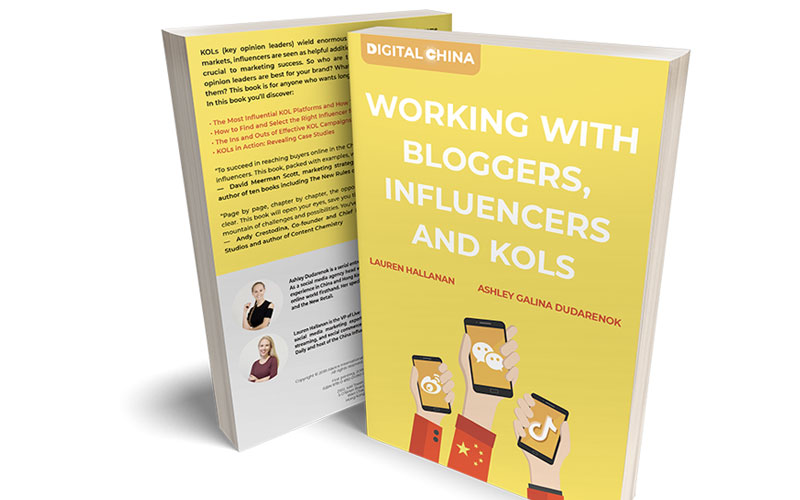We sat down with Chatly’s Head of Marketing and bestselling author Lauren Hallanan to find out the latest in China’s industry of influencer marketing, from KOCs to super apps.
As the Head of Marketing at Chatly, a CRM platform for WeChat, the China-based messaging app connecting one billion people, Lauren Hallanan is at the forefront of the influencer movement in China. The co-author of the Amazon bestselling book Digital China: Working with Bloggers, Influencers, and KOLs, she has appeared on BBC Radio, is a weekly host of the China Influencer Marketing Podcast, and regularly writes for Forbes and Jing Daily. She spoke to Hive Life about the growing industry of influencer marketing in China.

Back when Lauren started out, influencer marketing wasn’t even on the agenda. “Not to date myself or anything, but, when I was in college, social media marketing wasn’t really a career. It wasn’t an option,” she states. American-born Lauren studied International Relations in Pennsylvania before moving to China to study Mandarin. “I’ve always been very fascinated with other cultures and languages. I started playing around on a lot of Chinese social media platforms just for my own enjoyment,” she remembers. “I think it was a pretty natural progression of finally realising, ‘Oh, this is a fit for the interests that I’ve had for such a long time.”
Lauren found her niche in marketing whilst working in several PR, entertainment, and digital marketing positions. Since then she’s been a live streamer and TV anchor, and has even found her way onto one of China’s biggest reality shows. “Now, as part of my job, I get to continue studying the language and what’s going on in China,” she says. As for what Chatly actually does? “We’re gathering data on users, helping people set up their e-commerce mini-programs, and helping brands run their marketing strategies on WeChat. People interacting with your WeChat mini-programs then get retargeted, just like they would if they were browsing a website in the US, and of course, they open other pages and they start to see ads for those products. That’s really what we do at Chatly and I’m the Head of Marketing there,” she grins, shaking her head in disbelief.
Having witnessed the demand for social media influencers, Lauren dipped her toes in previously buzzed-about platforms Yi Zhi Buo and Hua Jiao, amongst many others, but her interest soon fizzled out. “I think live streaming can be very difficult because it’s unsustainable over the long term. So, I transitioned away from that into trying to build a following based on the knowledge that I had. I was thinking, how could I provide value to my audience? Which is more of what a KOL or influencer does, as opposed to just being an entertainer.”
You might also like The Ultimate Business Manual for China Marketing

As Lauren sees it, this sort of marketing is the only way for brands to gain traction in her market. “In China, people really don’t use email that much. They don’t visit websites that much. They don’t even use traditional search engines. So really, when you’re in China, it almost feels like social media platforms are the Internet,” she laughs. “It’s something that really doesn’t exist anywhere else in the world.”
With the rise of ‘super apps,’ going mobile is the best strategy to reach China’s massive economy, with WeChat being a case in point. “It has evolved from just being a chat app; it’s everything. For brands, it replaces the need to have a website. The entire customer lifecycle can take place on it. If customers are interacting with a brand’s official account or mini-program, they’ll start to receive some notifications and offers, and you’ll be able to collect data about your users, so you can retarget them just like you would if you were browsing a website in the US.”
In order to do so effectively, however, Lauren urges that you need to understand your market on its own terms. “Consumers are becoming savvier. They travel abroad much more; they’re becoming much more interested in and proud of their own culture and domestic brands. Any brand that’s trying to get into China will need to be very culturally sensitive,” she says. “For a lot of Western companies, it’s a bit of a struggle for some brands to trust the influencer more, because they can’t communicate or understand them as much, or because the style of the images or how they use your product might seem strange or different.”
And, even once they have identified a campaign to run, companies then need to cater it clearly to different categories. “Brands need to do segmented campaigns for niche audiences. Western brands don’t differentiate as much as they should – it’s about different age groups, different geographical locations. There are also a lot of Chinese people living abroad who have different tastes and behaviours than those living back in China,” Lauren pauses. “It’s absolutely crazy, the different types of consumers to consider. You really can’t blanket statement them.”

Huge luxury powerhouses like Dolce & Gabbana and Burberry have not been exempt from the scrutiny of the world’s second-largest economy. “As a foreign brand, you really can’t go in there anymore, acting like you know what you should do,” Lauren says matter-of-factly. “With everything that’s going on culturally and politically, you can’t be so proud of where you’re from and who you are that it offends,” Lauren says carefully. “But, neither can you give up your identity as, you know, an American. It’s a bit of a fine line.”
A successful campaign requires an understanding of what provokes emotion in your targeted user-base, Lauren says, “because when you’re using this product, it reflects your personality and who you are.” It’s in this space that Lauren thinks working with KOLs or KOCs (Key Opinion Customers) makes for a lucrative marketing strategy. The new influencer trend of KOCs, or what Lauren calls “micro-micro-micro influencers,” each who have a following of only a few thousand, lends authenticity to brands in a way commercialised recommendations can’t. Either way, influencers provide a wealth of cultural knowledge for businesses to target their user base and create a foundation of trust between consumer and brand.

With China’s own robust ecosystem of homegrown apps, it can be hard to gain a coveted brand reputation, particularly with a user base growing more sophisticated day-by-day. “Brands really need the ability to invest a lot of time, energy, money into getting it up and running in China. They’ll need to establish core products, and themselves, and build a reputation in their home market first because a lot of Chinese consumers will definitely do what they can to research a brand’s reputation. If you act like you’re one way here, and then you’re different over here, they’re going to see right through that.”
“Chinese consumers are looking to upgrade their lifestyles. They’re looking for higher-quality products, and just like anywhere else in the world, it’s going to have to be Instagrammable,” Lauren says, laughing. But she also reveals consumers from first and second-tier cities have surprisingly different spending habits from lower-tier cities. “They can take a lot more time to consider what they’re going to buy – they have less disposable income because the cost of living is higher. I think brands actually have to put even more effort into trying to persuade these consumers since they have less money to be playing around with.” Regardless of who businesses are appealing to, however, it’s clear that the voice of an influencer is crucial to coming out on top. As Lauren puts it, “Until you establish that brand reputation, it can be really hard to actually get any kind of return or conversion.”
Related Articles
SODA Shades: An Instagram Sensation
How to Succeed at Influencer Marketing
5 Growth-Hacking Strategies You Need to Grow Your Business Fast





